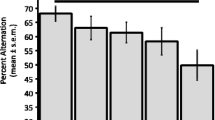Summary
Rats were trained to discriminate response produced cues in one component of a multiple schedule and the onset of a clicker in the other component. The response requirements were identical. Scopolamine intoxication resulted in a deterioration of the interoceptive cue discrimination and an improvement in the discrimination of the exteroceptive stimuli.
Similar content being viewed by others
References
Anger, D.: The dependence of inter-response times upon the relative reinforcement of different inter-response times. J. exp. Psychol. 52, 141–161 (1956).
- The role of temporal discriminations in the reinforcement of Sidman avoidance behavior. J. exp. Anal. Behav. 6, Supplement 1 (1963).
Berryman, B., W. Wagman, and F. S. Keller: Chlorpromazine and the discrimination of response produced cues. pp. 243–249. In: L. Uhr and J. G. Miller (Eds.) Drugs and Behavior. New York: Wiley 1960.
Boren, J. J., and A. P. Navarro: The action of atropine, benactyzine and scopolamine upon fixed interval and fixed ratio behavior. J. exp. Anal. Behav. 2, 107–116 (1955).
Carlton, P. L.: Cholinergic mechanisms in the control of behavior by the brain. Psychol. Rev. 70, 19–39 (1963).
- Brain—Acetylcholine and Habituation. In: Bradley, P. B., and M. Fink (Eds.). Progress in Brain Research. Amsterdam: Elsevier (in press).
Dews, P. B.: Studies on behavior: II. The effects of pentobarbital methamphetamine and scopolamine on performances in pigeons involving discriminations. J. Pharmacol. exp. Ther. 115, 380–389 (1955).
—: Studies on behavior: III. Effects of scopolamine on reversal of a discriminatory performance in pigeons. J. Pharmacol. exp. Ther. 119, 343–353 (1957).
Hearst, E.: Effects of scopolamine on discriminated responding in the rat. J. Pharmacol. exp. Ther. 126, 349–358 (1959).
Herrnstein, R. J.: Effects of scopolamine on a multiple schedule. J. exp. Anal. Behav. 1, 351–358 (1958).
Laties, V. G., and B. Weiss: Influence of drugs on behavior controlled by internal and external stimuli J. Pharmacol. exp. Ther. 152, 388–396 (1966).
Mechner, F.: Probability relations within response sequences under ratio reinforcement. J. exp. Anal. Behav. 1, 109–121 (1958).
Sidman, M.: The temporal distribution of avoidance responses. J. comp. physiol. Psychol. 47, 399–402 (1954).
Stone, C. G.: Effects of some centrally acting drugs upon learning of escape and avoidance habits. J. comp. physiol. Psychol. 53, 33–37 (1960).
Terrace, H. S.: Discrimination learning with and without “errors”. J. exp. Anal. Behav. 6, 1–27 (1963).
Weiskrantz, L., and M. Mishkin: Effects of temporal and frontal cortical lesions on auditory discrimination in the monkey. Brain 81, 406–414 (1958).
Winer, B. J.: Statistical Principles in Experimental Design. New York: McGraw 1962.
Author information
Authors and Affiliations
Additional information
In conducting the research reported herein, the investigators adhered to the “Principles of Laboratory Animal Care” as established by the National Society for Medical Research.
Rights and permissions
About this article
Cite this article
Wagman, W.D., Maxey, G.C. The effects of scopolamine hydrobromide and methyl scopolamine hydrobromide upon the discrimination of interoceptive and exteroceptive stimuli. Psychopharmacologia 15, 280–288 (1969). https://doi.org/10.1007/BF00401682
Received:
Revised:
Issue Date:
DOI: https://doi.org/10.1007/BF00401682



